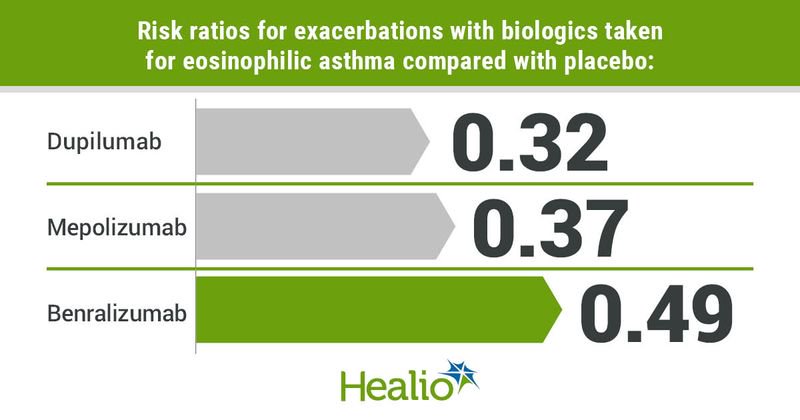Available biologics show similar effectiveness, safety for treating eosinophilic asthma
The biologics mepolizumab, dupilumab and benralizumab showed minimal differences in efficacy and safety in treating eosinophilic asthma, according to a review of eight studies published in The Journal of Allergy and Clinical Immunology.
However, these studies offered low to moderate certainty of evidence, Ayobami T. Akenroye, MBChB, MPH, an associate physician with the division of allergy and clinical immunology at Brigham and Women’s Hospital in Boston, and colleagues found.


“The number of monoclonal antibodies approved for the treatment of asthma continues to rise, and a significant number of patients will meet criteria for two or more of these biologics. However, there are no direct comparisons of these biologics, and little is known on how they compare,” Akenroye told Healio.
“In the U.S. alone, thousands of individuals with asthma annually will require a biologic for the control of their asthma. Thus, additional information on how these biologics compare will be helpful to patients and providers,” Akenroye continued.
The studies
The researchers examined data from eight randomized placebo-controlled trials published between Jan. 1, 2000, and Feb. 17, 2021. Clinically significant exacerbations served as the primary outcome of interest, and prebronchodilator FEV1 and Asthma Control Questionnaire (ACQ) scores were secondary outcomes.
Three of these studies compared mepolizumab (Nucala, GlaxoSmithKline) with placebo, three compared benralizumab (Fasenra, AstraZeneca) with placebo and two compared dupilumab (Dupixent, Sanofi Genzyme/Regeneron) with placebo.
There were 6,461 patients total in the eight studies, with a mean age range of 48 to 53 years. Also, 57% to 66% of the cohorts were women. Studies including racial or ethnic data reported white patients comprised 73% to 90% of their populations.
The findings
Among patients with eosinophil counts of 300 cells/µL or higher, compared with placebo, dupilumab (RR = 0.32; 95% CI, 0.23-0.45), mepolizumab (RR = 0.37; 95% CI, 0.3-0.45) and benralizumab (RR = 0.49; 95% CI, 0.43-0.55) all significantly reduced exacerbations.
Also, dupilumab (mean difference [MD], 230 mL; 95% CI, 160-300), benralizumab (MD, 150 mL; 95% CI, 100-200) and mepolizumab (MD, 150 mL; 95% CI, 66-220) all improved FEV1 compared with placebo in this population.
In terms of reducing ACQ scores, mepolizumab (MD, –0.63; 95% CI, –0.81 to –0.45), dupilumab (MD, –0.48; 95% CI, –0.83 to –0.14) and benralizumab (MD, –0.32; 95% CI, –0.43 to –0.21) outperformed placebo in this population as well.
In patients with eosinophil counts between 150 cells/µL and 299 cells/µL, researchers found an association between benralizumab (RR = 0.62; 95% CI, 0.52-0.73) and dupilumab (RR = 0.6; 95% CI, 0.38-0.95) and lower exacerbation rates, as well as an association between benralizumab (MD, 81 mL; 95% CI, 8-150) and improved FEV1, compared with placebo.
“We found that in individuals with moderate to severe asthma and eosinophils of 300 cells per microliter or greater, dupilumab and mepolizumab were more effective than benralizumab in reducing exacerbations, and mepolizumab was more effective than benralizumab in improving the Asthma Control Questionnaire,” Akenroye said.
“Importantly, we found that these differences were, in general, minimal and would not meet minimal clinical important thresholds, although these thresholds have not been well established,” Akenroye continued. “Our sample size was limited in making conclusions about the subgroup with eosinophils of 150 cells per microliter or greater.”
Across the full study population, the researchers further found an association between mepolizumab (OR = 0.67; 95% CI, 0.48-0.92) and benralizumab (OR = 0.74; 95% CI, 0.59-0.93) and lower odds for a severe adverse event.
Also, there were significantly lower odds for a severe adverse event with mepolizumab than with dupilumab (OR = 0.65; 95% CI, 0.41-1). However, there was no difference in odds for a severe adverse event between dupilumab and placebo (OR = 1; 95% CI, 0.74-1.4).
Evidence certainty
Noting that the dupilumab and benralizumab trials had large placebo effects on lung function and ACQ compared with the mepolizumab trials, the researchers rated the certainty of their evidence as moderate at best, with many comparisons having low or very low certainty.
“More information is still needed about the comparative effectiveness of these therapies at this time. We need to establish the minimal clinically important differences and evaluate the tolerability of these therapies in practice settings,” Akenroye said.
“This was a meta-analysis of randomized controlled trials. However, trial populations may not be representative of clinic populations. Thus, we will be extending this research question to real-world clinic populations,” Akenroye said.
Despite this low certainty and these minimal differences in outcomes, the researchers said their findings could help providers optimize patient care, although the chosen biologic also may depend on cost considerations, the timing of their administration and other factors.
For more information:
Ayobami Akenroye, MD, MPH, can be reached at aakenroye@bwh.harvard.edu.
